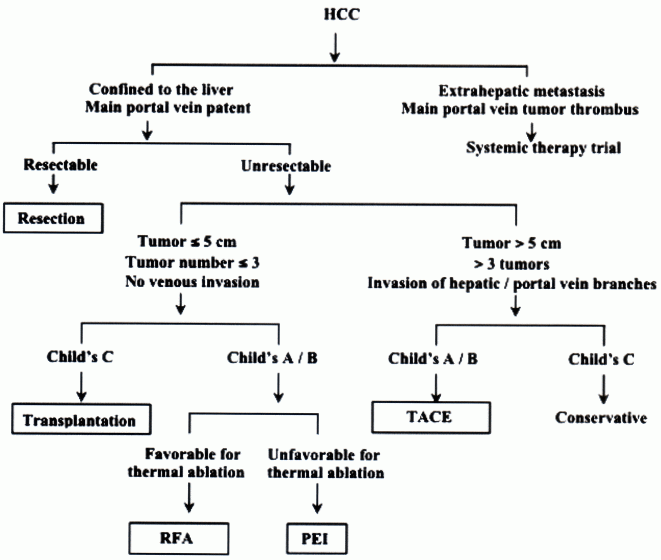Treatment Flowchart for Hepatocellular Carcinoma in Hepatitis B and C Patients
HCC,Hepatocellular Carcinoma; PEI,Percutaneous Ethanol Injection; RFA,Radio-frequency Ablation; TACE,Transarterial Chemoembolization.
RFA is done by using a high-frequency alternating current to cause thermal coagulation and protein denaturation of the targeted tissue. The procedure may be done by open surgery, laparoscopicaly, or percutaneously (See below). In all methods, the procedure is carried out using a needle electrode connected to a radiofrequency generator.
Advantages and disadvantages of the different methods of RFA
Open surgery:
* Allows the use of intraoperative ultrasonography which can identify upto 30% more tumours (not seen by preoperative imaging).
* More accuracy in targeting the tumours.
* Has the same recurrence rate as RFA done by laparoscopy.
Laparoscopic RFA:
* Has the same recurrence rate as RFA done by open surgery.
* Needs special additional training.
Percutaneous RFA:
* Major complications may occur (bilioperitoneum, intrahepatic abscess, acute thrombosis of the portal vein, necrosis of the diaphragm, colon, or stomach).
* Recurrence rate higher than that of RFA done by open surgery orlaparoscopy.
Related Topics:
Coblation: referred to as cold or controlled ablation, has recently been proposed as a therapy for surgical conditions. The method has been widely used in arthrosurgery, cardiosurgery, otorhinolaryngology, spinal surgery and aesthetic surgery.
Coblation bipolar technology uses radiofrequency energy to excite the electrolytes in a conductive medium, such as saline solution, creating (in vivo) a precisely focused plasma. The ionized plasma particles "bombard" the biological tissue at the intervention site, which leads to rupture of intermolecular cohesions. Thus the plasma particles are able to break molecular bonds within tissue, causing the tissue to dissolve at relatively low temperatures.
It is theorized that this "plasma radiofrequency-based microsurgery" may promote an angiogenic healing response. Because the radiofrequency current does not pass directly through tissue, there is minimal thermal injury to any surrounding tissues; as opposed to the great thermal injury of a CO2 laser. It is therefore safer than laser and does not need any safety measures, such as goggles.
Coblation can act as an electrosurgical unit and can coagulate the small vessels, achieving a bloodless surgical field.
Coblation technology can be delivered via a number of different hand pieces, wands and other electrosurgical systems. The devices are small and light in weight.
The "ArthroCare" Company (USA) was the first to start developing this technology. Under the FDA 510(k) approval process, the manufacturer is not required to supply to the FDA evidence of the effectiveness of the product to be marketed. The ArthroCare Topaz™ ArthroWands were the first to receive such FDA recognition on March 6, 2006.
Previous page
